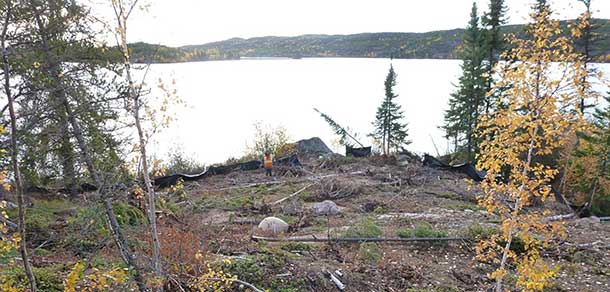Imagine your excitement should you find in that old shoebox in the basement one of your favourite hockey cards that dates back 40 or 50 years.
Sure, it’s a little rough around the edges but otherwise it’s in relatively good condition considering its age.
Now imagine you’re an archaeologist or a geologist digging in the ground and unearthing an artifact approximately 5,000 years old. Indeed that is a rare find, even more so than your Gordie Howe card from the shoebox.
There’s buried treasure under our feet and David Sanscartier, an environmental engineer with the Saskatchewan Research Council, was one of the lucky ones who in 2016 was present during a dig in northern Saskatchewan where an ancient projectile point was discovered.
It was during Project Cleans, a large-scale, multi-site remediation project and a cleanup of abandoned sites in the North, when this well-aged cultural piece was found on the shore of Jean Lake, approximately two kilometres northwest of Uranium City.

“This was a pretty exciting find,” Sanscartier explained. “I never expected we would find any artifact on those mine sites, so that was veryinteresting.”
Alan Korejbo is a senior archaeologist from Canada North Environmental Services who was surveying the abandoned Cayzor Athabasca Mine when he discovered the projectile point.
“Although archaeologists develop a sharp eye to detect such things, the moment one discovers a pristine artifact that has likely lain dormant over several millennia is almost always surreal,” Korejbo said during an interview with the SRC. “The imagination begins to take over trying to determine what this person was doing here. How did they live? What did they eat? What did their family or group look like? These are some very important cultural questions.”
“After the discovery, we surveyed the site’s surface to see if further heritage resources such as stone tools or features like fire hearths or stone cairns were visible on the surface. We didn’t find any other heritage resources and the site was accurately mapped and recorded.”
And therein lies the collaborative workings between environmental engineers like Sanscartier and geologists and archaeologists like Korejbo at remote sites, and how all work in unison to discover and preserve found artifacts.
Archaeologists, geologists and engineers assume different roles at a work site. While artifacts and skeletal remains and any remnants of past civilizations are studied by the archaeologist, geologists are focused on the solid and liquid materials in the earth, including soils, minerals and rocks.
Communication at work sites is paramount.
“The interaction with the archaeologists on (Project Cleans) was informative and I learned quite a bit through that. But also the communication we had with the local community was interesting too because once we found the artifact we contacted the leaders on those First Nation for some guidance on how to best deal with the cultural artifact.”
Archaeologists assist geologists and engineers with integrating and protecting social heritage and cultural resources into the remediation planning and operations.
Typically the archaeologist will be given the plans for the summer dig season to tell them which land geologists will be disturbing. With that information, archaeologists are free to go about their work and determine what kind of survey will be needed.
“Sometimes we have overlap. When we have the archaeologists on site we’ll have some of our internal resources going with that individual. We’re all looking for different things in many cases based on our specific areas of expertise,” explained Ian Wilson, an environmental remediation manager at the SRC who worked on Project Cleans.
“While an archaeologist is doing a pre-assessment of, for example, a forested area, to make efficiencies, geologists and engineers go out with a biologist and walk over the same ground to look for rare plant species or certain biological screens. That way, they’re going over the same areas and seeing the same things and so we get multiple surveys and filters going on at the same time.”
“That really helps us out because all the mines (on Project Cleans) have already been impacted, so there’s definitely potential there for findings,” Wilson continued. “When we’re pre-screening areas that haven’t been affected by man, it’s not only about finding things but also looking for areas from a biological and archaeological view where there could be potential.”
“The two parties share everything they find because the work the archaeologists do often supports or could potentially impact what the engineers and geologists and the remediation project team does. It’s not out of the realm of possibility that plans change or become delayed at a site, depending on what is found, to allow a full investigation.”
“This is not archaeology as an academic endeavour where maybe there’s some secrecy,” Sanscartier noted. “This is very much the archaeologist supporting the overall project and there is ongoing communication and sharing of information throughout.”
Added Wilson, “A lot of the time, we see that as value added from a regulatory standpoint and from a cultural standpoint.”
Saskatchewan remains a rich province to conduct research. The majority of the findings and the knowledge learned has been gleaned from materials found generally in the southern half of the province, given the extensive development.
Despite limited and isolated development in the northern half, research is conducted, though the study area hasn’t been as extensive as it has been in the South. This means there is a lot more cultural and archaeological awareness mapping.
But engineers go where the work is and the project portfolio is generally in the northwest corner of the province.
“The area where we are working (for Project Cleans) is extremely interesting from an archaeological viewpoint and from a cultural heritage viewpoint,” Wilson explained. “It’s beautiful up there, so if we were to choose a place within Saskatchewan, even though we don’t get to it, I think we’re in a good place.”
PHOTO TOP: An area near the Cayzor Athabasca Mine where ancient Indigenous artifacts were discovered.
